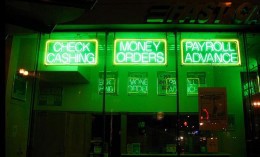What a Professor Studying Low-Income Communities Discovered After Working for a Payday Lender

Lisa Servon studies low-income communities and is a professor of urban policy at the New School in New York. Partly to make money so she could make ends meet, and partly to get an inside look at payday lenders, Servon decided to work at a check-cashing place in the Bronx and at a payday lender in California.
Servon had preconceived notions that these kinds of places were predatory and abusive — and they sometimes are — but she gained a better understanding of how the unbanked, or those who live close to the edge, use check-cashing to work for them. She explained how this works to The Guardian:
You mentioned people having preconceptions when it comes to check-cashing places. Can you talk a little bit about the fees involved and how they compare with banks?
One of the key things that hass happened [since the 2008 financial crisis] is that you have more and more people who are living paycheck to paycheck. So for example, in the Bronx 75% of the people have no discretionary income. There is zero slack in their budget.
So one of the things that becomes incredibly important to them is being able to get their money fast and to have liquidity. If you go to the bank, they want to hold on to your check until it clears. It’s less risk for them. Whereas at the check casher, they charge you a little bit of money — in New York State, it’s 1.95% of the face value, which is about the lowest. In California, it’s more. People are really aware that they are paying that. They are paying that price for liquidity.
The other thing is that if you were to map the increase in the check-cashing industry over the last 10 years there would be another line that would look very similar on the graph. That would be the increases in bank fees. If you compare it to 10 years ago, ATM fees have gone up, monthly service fees have gone up. Last year overdraft fees were at an all-time high — I think it was $38bn. So there is that piece of the situation: the straight-up cost of banking.
The other piece of the situation is transparency. In a sense, check-cashers have their signs right there. You walk into a bank, it might look nice, but there is no signage anywhere. I sometimes think: what if I were an immigrant and someone said, ‘You should open up a bank account,’ and I don’t speak English. I walk in and there’s nothing there that tells me what’s going on in this place.
Photo: Orin Zebest
Support The Billfold
The Billfold continues to exist thanks to support from our readers. Help us continue to do our work by making a monthly pledge on Patreon or a one-time-only contribution through PayPal.
Comments